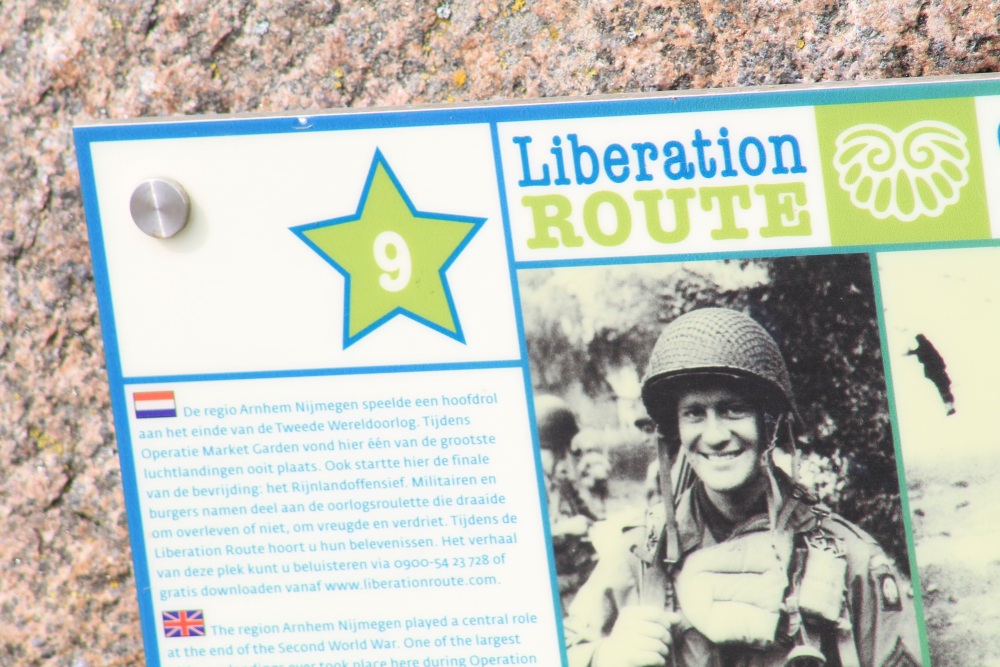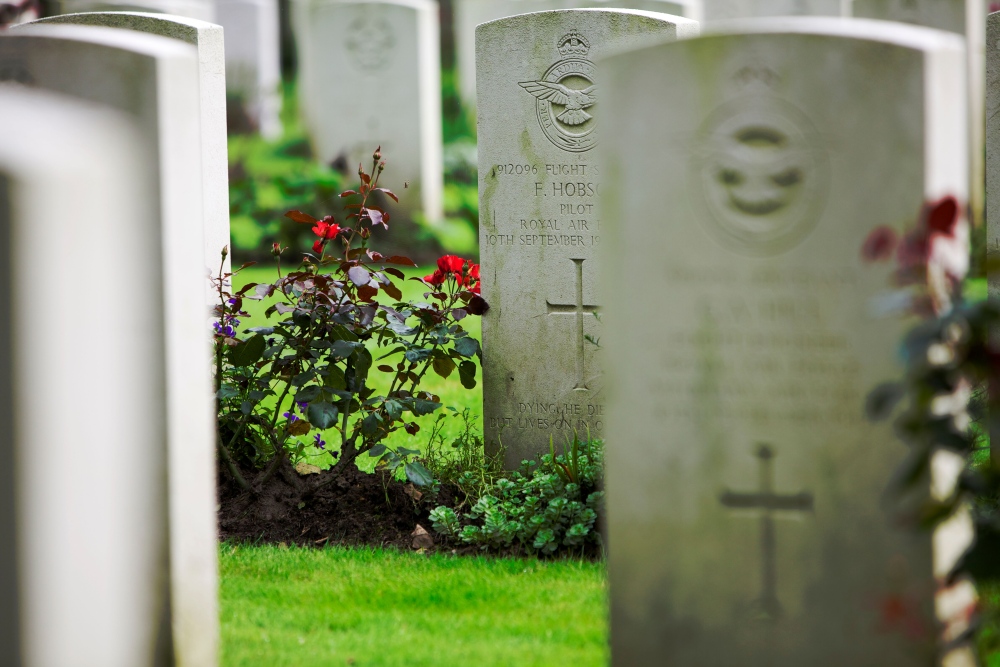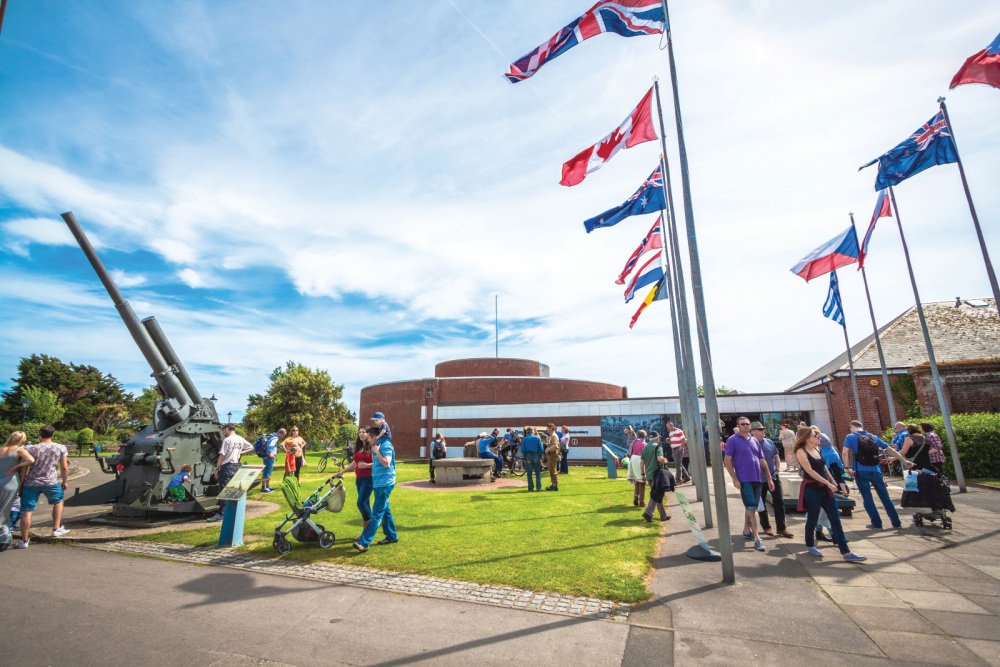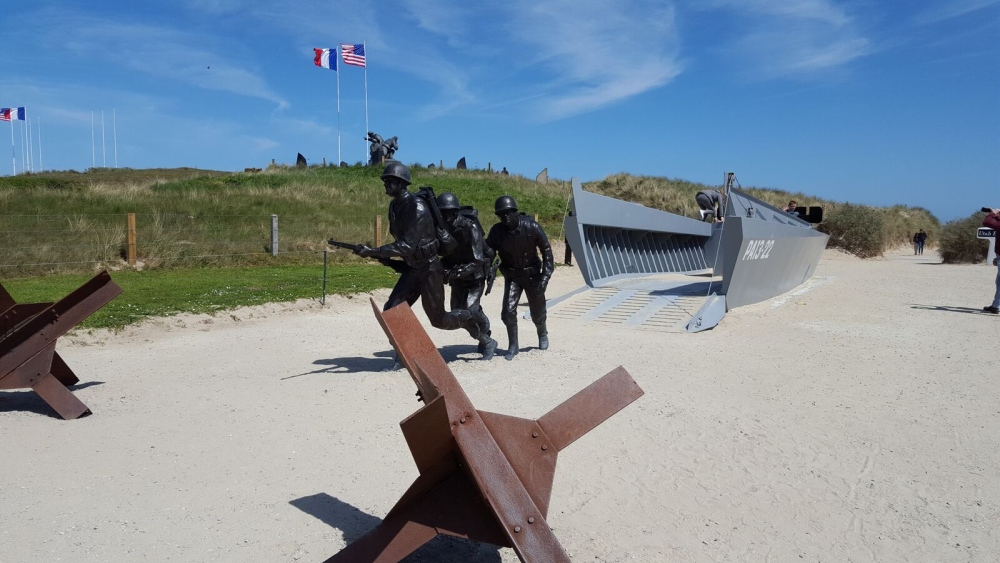Rough Guides follows in the footsteps of the liberators
On 1 July 2019 Liberation Route Europe Foundation and Rough Guides present a travel book about the liberation of Europe during World War II, titled "Travel the Liberation Route Europe". The book covers hundreds of locations through regions in nine different countries, focusing on the liberation routes of the Allied advance. TracesOfWar.com asked the authors, Nick Inman and Joe Staines some questions by e-mail.
What exactly is the Liberation Route Europe Foundation? When did this Dutch project become a European one?
Liberation Route Europe (LRE) is a continuously growing, international remembrance trail, which connects important milestones from modern European history. It forms a link between the main regions impacted by the Liberation of Europe in 1944–45 and is managed by the Liberation Route Europe Foundation.

Audio spot of the Liberation Route at Groesbeek. Photo: Liberation Route Europe
It began as a small regional project in the Arnhem–Nijmegen area of the Netherlands, where Operation Market Garden and Operation Veritable took place in 1944–1945. Three of the area’s museums joined forces with the Regional Tourist Board Arnhem Nijmegen to raise awareness of local World War II history by telling its stories and promoting its remembrance sites.
The initial project met with enthusiasm, and quickly spread to provinces all over the Netherlands. Its immediate popularity prompted the founders to investigate the possibility of expanding into other European nations. When they had successfully joined together with partners from five other countries, the idea of creating a transnational remembrance trail was born, linking the regions, sites and stories of the Liberation across Europe.
How did you as writers become involved in this project?
Nick Inman is a travel writer who specializes in France (where he lives) and Europe. He has worked for the APA-owned Insight Guides for a long time. When APA acquired Rough Guides in 2017, he was asked to work on the first new Rough Guide title, Travel the Liberation Route Europe.
Joe Staines is a freelance editor and author specializing in art, culture and history. He was known to Rough Guides, having worked for them from 1999 to 2012 as both writer and editor on their non-travel, reference book titles, and more recently as a travel editor.
There are other WW2 travel guides, how does this book distinguish itself?
Our book concentrates exclusively on the liberation routes across the whole of Europe (from both west and east), rather than focusing on just one country as other titles tend to. Though the military operations of the Western Allies form the core of the book, we were determined to avoid giving an entirely Anglo-American view of the liberation, and have tried to convey something of the experience of life under Nazi occupation and the ambiguities of being liberated by the Soviets. We also try to tell a story that can be read independently of the sightseeing, so you could enjoy the book at home in your armchair. There are plenty of photos and maps as well as additional information and context – for example, features covering such topics as European resistance movements, the Holocaust, and post-war reconstruction.

Cemetery of the Commonwealth in the Reichswald. Photo: Liberation Route Europe
Is this the first book you wrote together? What was your division of roles?
Yes, this was our first book together. Nick worked out the synopsis of the book in consultation with Rough Guides and LRE, Joe then joined the team as Nick’s co-writer. Apart from utilizing Nick’s specialist knowledge of French history and culture, the work was divided according to our particular interests. We both critiqued each other’s work and made suggestions as we went along, an arrangement which worked extremely well.
The book describes Italy, the United Kingdom, France, Belgium and Luxembourg, The Netherlands, Poland, Czech Republic and Germany. Did you visit all locations yourself?
We both visited many of the sites, but due to budgetary and time restraints, we also relied on the expertise of the team at Liberation Route Europe who supplied us with first-hand information about the sites they regarded as the most significant.
The United Kingdom is also included but was never occupied (and so not liberated). Why did you decide to include this country and what kind of specific locations are described?
The UK was where the Liberation of Europe was planned and organised, and where millions of troops gathered prior to the invasion of France. We wanted to cover this aspect of the story, so it seemed essential to include the UK. There were many UK sites we could have included, but in the end we concentrated mostly on those in the south of England: both the obvious ones, such as the Churchill War Rooms in London and the D-Day Story museum in Portsmouth, and the less obvious, for example, Hayling Island in Hampshire and the Romney, Hythe & Dymchurch Railway in Kent. Among the handful of northern sites are the Yorkshire Air Museum and the Western Approaches Museum in Liverpool.

The D-Day Story museum at Portsmouth. Photo: Liberation Route Europe
Of course you couldn’t add all museums and other locations in this book. How did you make a selection?
With difficulty. The museums and military installations were relatively easy to prioritize but it was very difficult choosing which of the many war cemeteries to include. We made initial long lists and then considered various criteria – such as importance – while trying to convey the sheer variety of the types of sites that can be visited. The book was a collaborative effort between Liberation Route Europe and Rough Guides, so LRE’s ongoing work on the ground helped in our selection, but there was also scope to include recently constructed memorials and museums. The International Bomber Command Centre near Lincoln was one of these, as was the Museum of the Second World War in Gdańsk.
Of all locations you visited and/or described; which did you find the most impressive and why?
Nick: Personally, while I find the well-known sights impressive, what I look for are places that bring the war back to the level of humanity. I have a particular interest in the lesser-told stories of the liberation, especially the liberation movements in France and Italy. For example, a maquis cabin in the woods or a small museum assembled by an enthusiastic local association may not be covered in the standard books and there may not even be that much to see but there is always a lot to imagine and to feel.
Joe: In the sense of making an indelible impression, I would have to say Auschwitz II-Birkenau. After visiting Auschwitz I, many people do not continue on to the nearby camp at Brzezinka, and the lack of crowds reinforces the sheer horrific bleakness of the place. It is harrowing site to visit, but a vital reminder of why the murderous Nazi regime had to be stopped.

Monument at Utah Beach. Photo: Liberation Route Europe
What do you hope to achieve with this book? Is it especially aimed at the youth, who travel a lot through Europe?
The book is about remembering the culmination of one of the most catastrophic events in European history. Not an event to be glorified or gloated about, but to be understood. The war is a reminder of how the breakdown of politics can unleash disaster. It tells of big global occurrences but also contains many individual narratives. Though relatively recent, most of the participants are either dead or at the end of their lives. Remembering and discussing what occurred is important for all generations, not just the young, and visiting specific sites – whether it’s the beaches of Normandy or the forests of the Ardennes – adds an extra and vivid dimension to the understanding of what went on. We want the book to remind people that World War II was an immensely complicated period of history, and not the simple story of good versus evil that it is often reduced to.
10. Do either of you have any personal connections to the Liberation?
While working on the book we both realized that close family members had been in Europe during the Liberation.
Nick: I knew my dad David Inman was involved in the very end of the war but I had never bothered to find out exactly what role he had. Doing the book gave me the impetus to listen to the recording I had made of his life and ask for his army record. He was in the Royal Artillery and in January 1945 was posted to the Netherlands. He was initially stationed at Nijmegen and in April his division took part in the liberation of Arnhem and Ede. Following the defeat of Germany, his unit guarded a refugee camp. He spent the aftermath of the war in Trieste and then in Gaza, where he was promoted to sergeant, before being demobbed in September 1947.
Joe: In 1944 my mother Pauline Letts was acting in a play, A Soldier for Christmas, in London’s West End. At the end of the year, it was decided to take the show on a tour that followed the Allied troops through newly liberated France, Belgium and the Netherlands. It was organized by the Entertainments National Service Association (ENSA), which laid on a whole range of entertainments for British troops throughout the war. While on the road, my mother kept a diary: a mish-mash of observations about the privations people were still enduring, gossip about her fellow cast members, accounts of shopping for gifts to take home, and shock at acting in a theatre where a few weeks earlier German entertainers had performed (and left their signatures on the dressing room walls).


What exactly is the Liberation Route Europe Foundation? When did this Dutch project become a European one?
Liberation Route Europe (LRE) is a continuously growing, international remembrance trail, which connects important milestones from modern European history. It forms a link between the main regions impacted by the Liberation of Europe in 1944–45 and is managed by the Liberation Route Europe Foundation.

It began as a small regional project in the Arnhem–Nijmegen area of the Netherlands, where Operation Market Garden and Operation Veritable took place in 1944–1945. Three of the area’s museums joined forces with the Regional Tourist Board Arnhem Nijmegen to raise awareness of local World War II history by telling its stories and promoting its remembrance sites.
The initial project met with enthusiasm, and quickly spread to provinces all over the Netherlands. Its immediate popularity prompted the founders to investigate the possibility of expanding into other European nations. When they had successfully joined together with partners from five other countries, the idea of creating a transnational remembrance trail was born, linking the regions, sites and stories of the Liberation across Europe.
How did you as writers become involved in this project?
Nick Inman is a travel writer who specializes in France (where he lives) and Europe. He has worked for the APA-owned Insight Guides for a long time. When APA acquired Rough Guides in 2017, he was asked to work on the first new Rough Guide title, Travel the Liberation Route Europe.
Joe Staines is a freelance editor and author specializing in art, culture and history. He was known to Rough Guides, having worked for them from 1999 to 2012 as both writer and editor on their non-travel, reference book titles, and more recently as a travel editor.
There are other WW2 travel guides, how does this book distinguish itself?
Our book concentrates exclusively on the liberation routes across the whole of Europe (from both west and east), rather than focusing on just one country as other titles tend to. Though the military operations of the Western Allies form the core of the book, we were determined to avoid giving an entirely Anglo-American view of the liberation, and have tried to convey something of the experience of life under Nazi occupation and the ambiguities of being liberated by the Soviets. We also try to tell a story that can be read independently of the sightseeing, so you could enjoy the book at home in your armchair. There are plenty of photos and maps as well as additional information and context – for example, features covering such topics as European resistance movements, the Holocaust, and post-war reconstruction.

Is this the first book you wrote together? What was your division of roles?
Yes, this was our first book together. Nick worked out the synopsis of the book in consultation with Rough Guides and LRE, Joe then joined the team as Nick’s co-writer. Apart from utilizing Nick’s specialist knowledge of French history and culture, the work was divided according to our particular interests. We both critiqued each other’s work and made suggestions as we went along, an arrangement which worked extremely well.
The book describes Italy, the United Kingdom, France, Belgium and Luxembourg, The Netherlands, Poland, Czech Republic and Germany. Did you visit all locations yourself?
We both visited many of the sites, but due to budgetary and time restraints, we also relied on the expertise of the team at Liberation Route Europe who supplied us with first-hand information about the sites they regarded as the most significant.
The United Kingdom is also included but was never occupied (and so not liberated). Why did you decide to include this country and what kind of specific locations are described?
The UK was where the Liberation of Europe was planned and organised, and where millions of troops gathered prior to the invasion of France. We wanted to cover this aspect of the story, so it seemed essential to include the UK. There were many UK sites we could have included, but in the end we concentrated mostly on those in the south of England: both the obvious ones, such as the Churchill War Rooms in London and the D-Day Story museum in Portsmouth, and the less obvious, for example, Hayling Island in Hampshire and the Romney, Hythe & Dymchurch Railway in Kent. Among the handful of northern sites are the Yorkshire Air Museum and the Western Approaches Museum in Liverpool.

Of course you couldn’t add all museums and other locations in this book. How did you make a selection?
With difficulty. The museums and military installations were relatively easy to prioritize but it was very difficult choosing which of the many war cemeteries to include. We made initial long lists and then considered various criteria – such as importance – while trying to convey the sheer variety of the types of sites that can be visited. The book was a collaborative effort between Liberation Route Europe and Rough Guides, so LRE’s ongoing work on the ground helped in our selection, but there was also scope to include recently constructed memorials and museums. The International Bomber Command Centre near Lincoln was one of these, as was the Museum of the Second World War in Gdańsk.
Of all locations you visited and/or described; which did you find the most impressive and why?
Nick: Personally, while I find the well-known sights impressive, what I look for are places that bring the war back to the level of humanity. I have a particular interest in the lesser-told stories of the liberation, especially the liberation movements in France and Italy. For example, a maquis cabin in the woods or a small museum assembled by an enthusiastic local association may not be covered in the standard books and there may not even be that much to see but there is always a lot to imagine and to feel.
Joe: In the sense of making an indelible impression, I would have to say Auschwitz II-Birkenau. After visiting Auschwitz I, many people do not continue on to the nearby camp at Brzezinka, and the lack of crowds reinforces the sheer horrific bleakness of the place. It is harrowing site to visit, but a vital reminder of why the murderous Nazi regime had to be stopped.

What do you hope to achieve with this book? Is it especially aimed at the youth, who travel a lot through Europe?
The book is about remembering the culmination of one of the most catastrophic events in European history. Not an event to be glorified or gloated about, but to be understood. The war is a reminder of how the breakdown of politics can unleash disaster. It tells of big global occurrences but also contains many individual narratives. Though relatively recent, most of the participants are either dead or at the end of their lives. Remembering and discussing what occurred is important for all generations, not just the young, and visiting specific sites – whether it’s the beaches of Normandy or the forests of the Ardennes – adds an extra and vivid dimension to the understanding of what went on. We want the book to remind people that World War II was an immensely complicated period of history, and not the simple story of good versus evil that it is often reduced to.
10. Do either of you have any personal connections to the Liberation?
While working on the book we both realized that close family members had been in Europe during the Liberation.
Nick: I knew my dad David Inman was involved in the very end of the war but I had never bothered to find out exactly what role he had. Doing the book gave me the impetus to listen to the recording I had made of his life and ask for his army record. He was in the Royal Artillery and in January 1945 was posted to the Netherlands. He was initially stationed at Nijmegen and in April his division took part in the liberation of Arnhem and Ede. Following the defeat of Germany, his unit guarded a refugee camp. He spent the aftermath of the war in Trieste and then in Gaza, where he was promoted to sergeant, before being demobbed in September 1947.
Joe: In 1944 my mother Pauline Letts was acting in a play, A Soldier for Christmas, in London’s West End. At the end of the year, it was decided to take the show on a tour that followed the Allied troops through newly liberated France, Belgium and the Netherlands. It was organized by the Entertainments National Service Association (ENSA), which laid on a whole range of entertainments for British troops throughout the war. While on the road, my mother kept a diary: a mish-mash of observations about the privations people were still enduring, gossip about her fellow cast members, accounts of shopping for gifts to take home, and shock at acting in a theatre where a few weeks earlier German entertainers had performed (and left their signatures on the dressing room walls).

- Travel the Liberation Route Europe
- Sight and experiences along the path of the World War II allied advance
- ISBN: 9781789194302
- More information about this book


Used source(s)
- Source: TracesOfWar / Rough Guides
- Published on: 12-06-2019 19:30:03
Related news
- 23-06: Keeping the memory of the trails to freedom alive
- 12-04: Understanding the German side of the fighting in Normandy
- 11-'24: Postal artifacts provide a vibrant testament to the experiences of the Dutch people during WWII
- 10-'24: DigitalBattlefieldTours unlocks military tactics to a wide audience
- 08-'24: Researching his father’s WWII history became a passion for Steve Snyder
Latest news
- 03-10: Photo report other Airborne commemorations and events 2025
- 01-10: Photo report commemoration Wiltshire memorial
- 30-09: Photo report other Airborne commemorations and events 2025
- 26-09: Photo report Ounveiling Plaque 'Gunners within 1st Airborne Division'
- 25-09: Photo report unveiling Plaque 'Gunners within 1st Airborne Division'
- 24-09: Photo report Airborne commemoration Driel
- 23-09: Photo report Airborne Landing and Commemoration
- 22-09: Photo report Airborne Memorial Service Oosterbeek
- 23-06: Keeping the memory of the trails to freedom alive
- 12-04: Understanding the German side of the fighting in Normandy


